Audit Assertions in Practice: Case Studies of Financial Verification
VerifiedAdded on 2023/04/23
|12
|3068
|173
Case Study
AI Summary
This assignment provides a comprehensive analysis of audit assertions through two case studies: Advanced Computer Solutions and Green Machine Ltd. The first case examines inventory management at Advanced Computer Solutions, focusing on the key assertions of authorization and accuracy. It details substantive procedures for verifying these assertions and discusses the importance of communicating key audit matters in the auditor's report. The second case study assesses property, plant, and equipment at Green Machine Ltd, highlighting valuation and ownership as critical assertions. It outlines substantive procedures for validating these assertions, emphasizing the need for proper documentation and reporting in financial statements. The assignment concludes by stressing the importance of audit assertions in ensuring the fair representation of financial information.

Paraphrase This Document
Need a fresh take? Get an instant paraphrase of this document with our AI Paraphraser

By student name
Professor
University
Date: 22nd Jan 2018.
Page 1
Professor
University
Date: 22nd Jan 2018.
Page 1
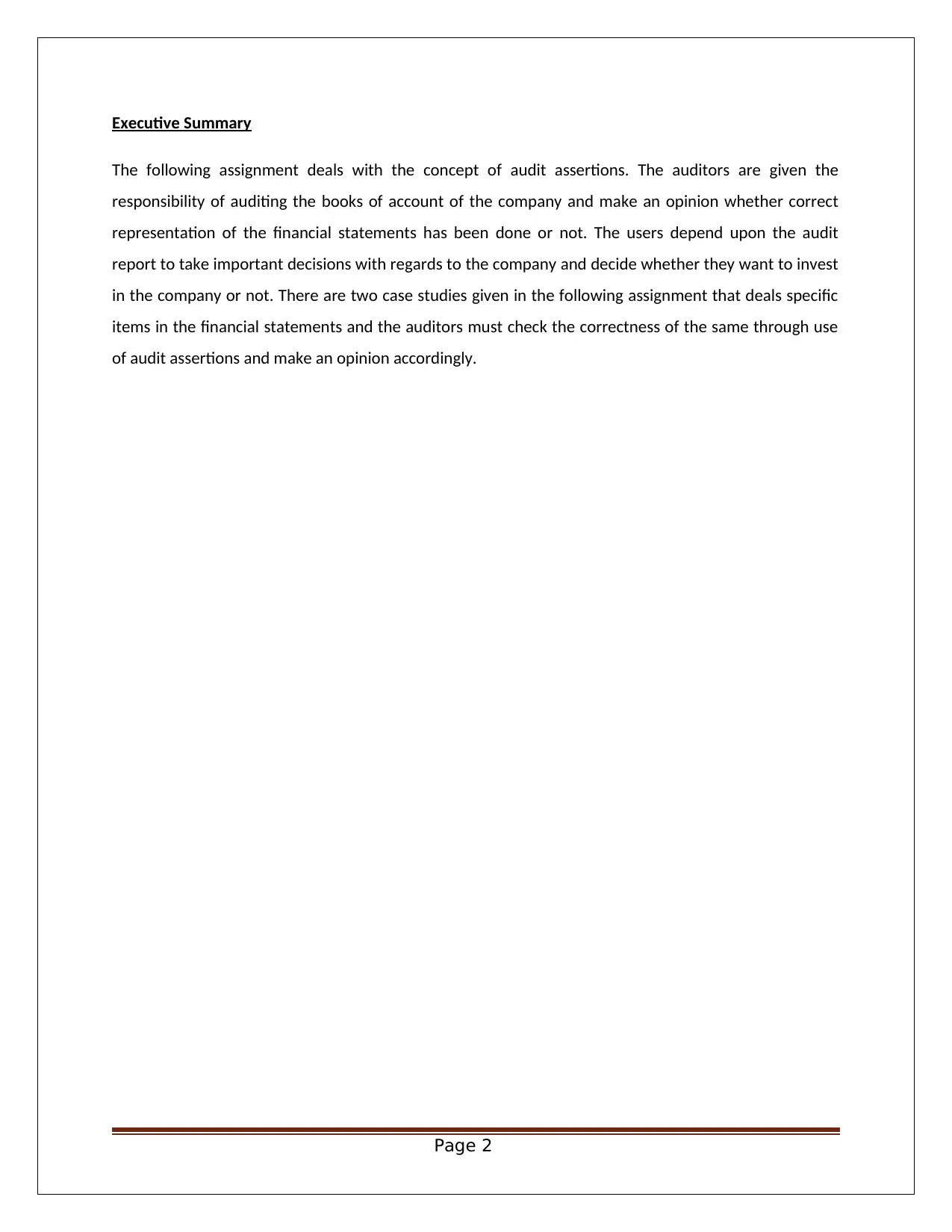
Executive Summary
The following assignment deals with the concept of audit assertions. The auditors are given the
responsibility of auditing the books of account of the company and make an opinion whether correct
representation of the financial statements has been done or not. The users depend upon the audit
report to take important decisions with regards to the company and decide whether they want to invest
in the company or not. There are two case studies given in the following assignment that deals specific
items in the financial statements and the auditors must check the correctness of the same through use
of audit assertions and make an opinion accordingly.
Page 2
The following assignment deals with the concept of audit assertions. The auditors are given the
responsibility of auditing the books of account of the company and make an opinion whether correct
representation of the financial statements has been done or not. The users depend upon the audit
report to take important decisions with regards to the company and decide whether they want to invest
in the company or not. There are two case studies given in the following assignment that deals specific
items in the financial statements and the auditors must check the correctness of the same through use
of audit assertions and make an opinion accordingly.
Page 2
⊘ This is a preview!⊘
Do you want full access?
Subscribe today to unlock all pages.

Trusted by 1+ million students worldwide
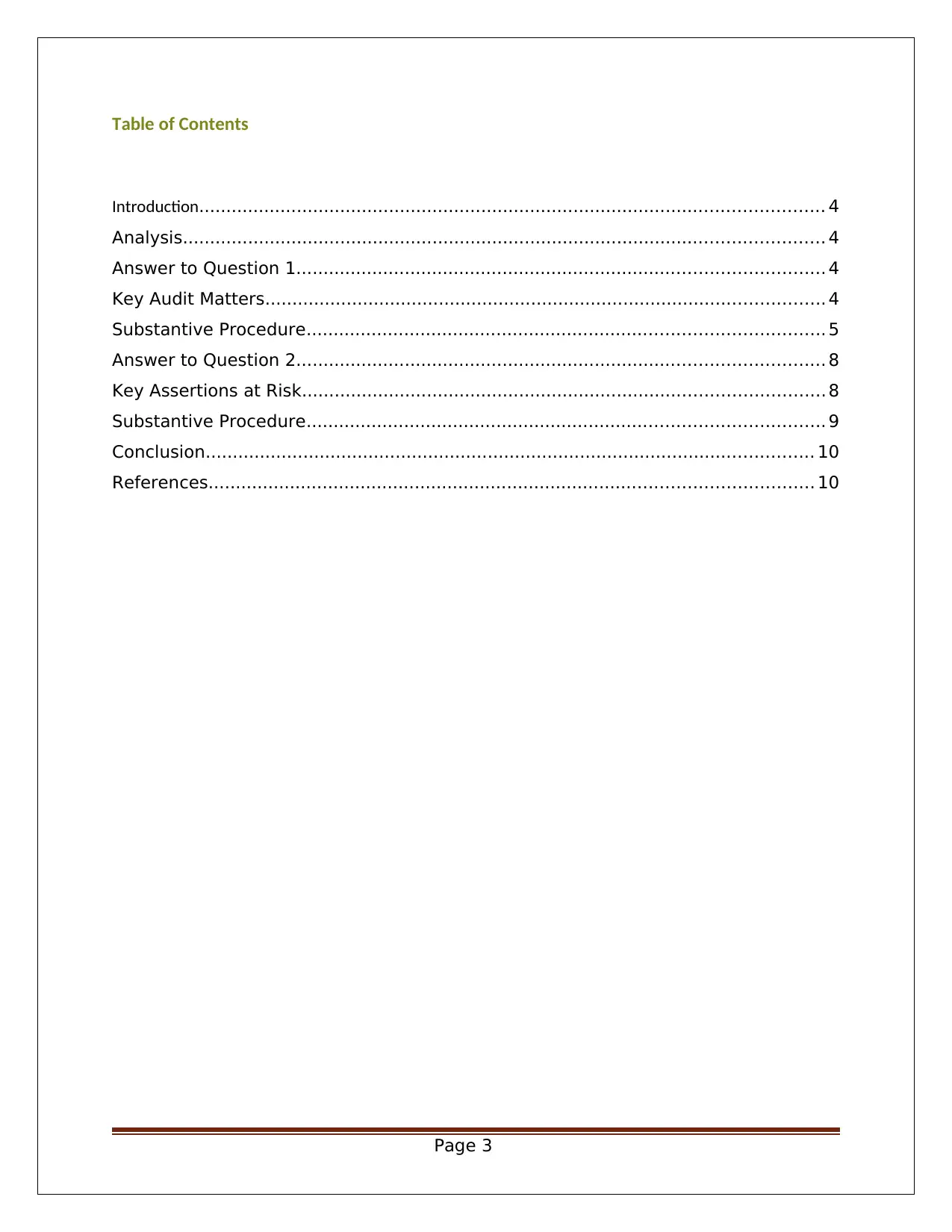
Table of Contents
Introduction................................................................................................................... 4
Analysis...................................................................................................................... 4
Answer to Question 1................................................................................................. 4
Key Audit Matters....................................................................................................... 4
Substantive Procedure............................................................................................... 5
Answer to Question 2................................................................................................. 8
Key Assertions at Risk................................................................................................ 8
Substantive Procedure............................................................................................... 9
Conclusion................................................................................................................ 10
References............................................................................................................... 10
Page 3
Introduction................................................................................................................... 4
Analysis...................................................................................................................... 4
Answer to Question 1................................................................................................. 4
Key Audit Matters....................................................................................................... 4
Substantive Procedure............................................................................................... 5
Answer to Question 2................................................................................................. 8
Key Assertions at Risk................................................................................................ 8
Substantive Procedure............................................................................................... 9
Conclusion................................................................................................................ 10
References............................................................................................................... 10
Page 3
Paraphrase This Document
Need a fresh take? Get an instant paraphrase of this document with our AI Paraphraser
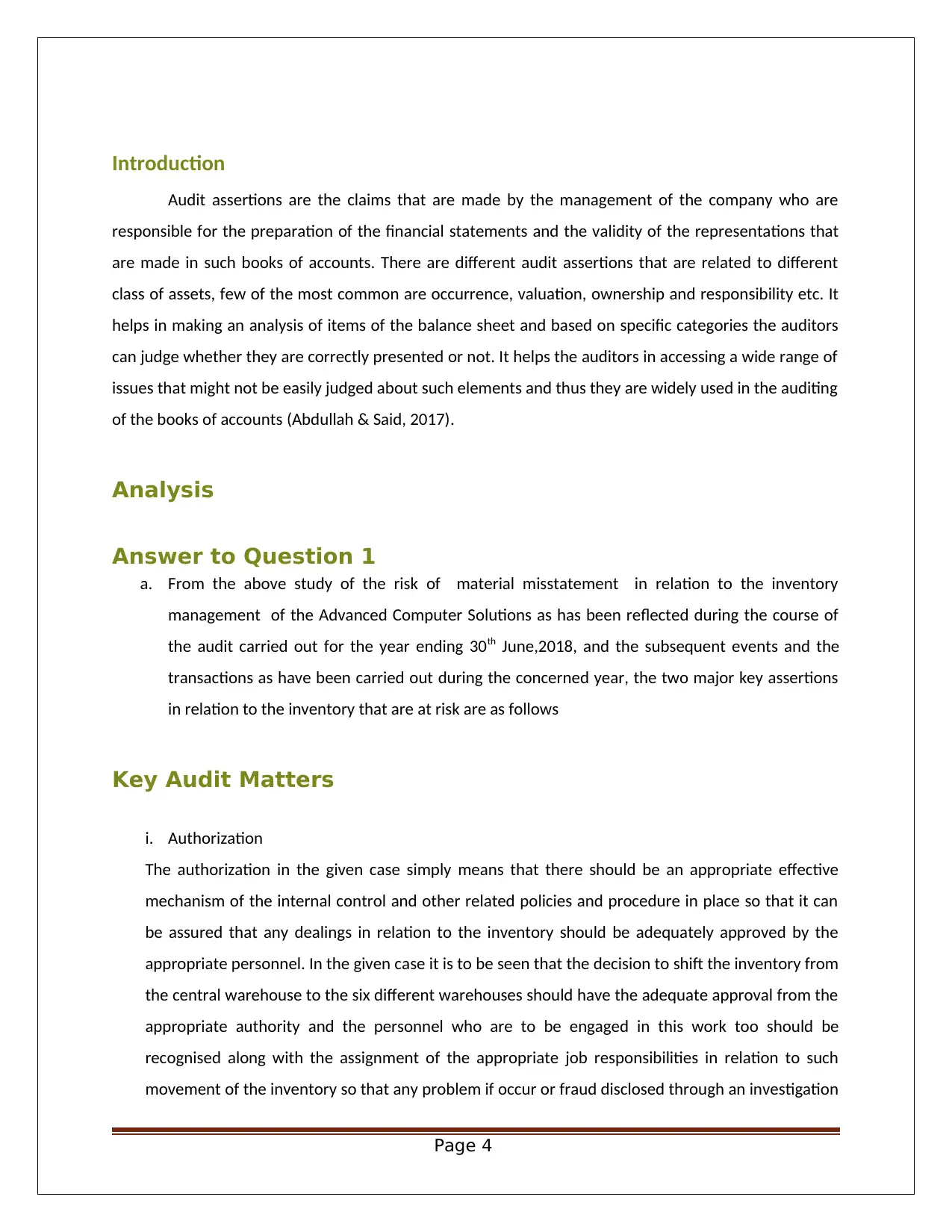
Introduction
Audit assertions are the claims that are made by the management of the company who are
responsible for the preparation of the financial statements and the validity of the representations that
are made in such books of accounts. There are different audit assertions that are related to different
class of assets, few of the most common are occurrence, valuation, ownership and responsibility etc. It
helps in making an analysis of items of the balance sheet and based on specific categories the auditors
can judge whether they are correctly presented or not. It helps the auditors in accessing a wide range of
issues that might not be easily judged about such elements and thus they are widely used in the auditing
of the books of accounts (Abdullah & Said, 2017).
Analysis
Answer to Question 1
a. From the above study of the risk of material misstatement in relation to the inventory
management of the Advanced Computer Solutions as has been reflected during the course of
the audit carried out for the year ending 30th June,2018, and the subsequent events and the
transactions as have been carried out during the concerned year, the two major key assertions
in relation to the inventory that are at risk are as follows
Key Audit Matters
i. Authorization
The authorization in the given case simply means that there should be an appropriate effective
mechanism of the internal control and other related policies and procedure in place so that it can
be assured that any dealings in relation to the inventory should be adequately approved by the
appropriate personnel. In the given case it is to be seen that the decision to shift the inventory from
the central warehouse to the six different warehouses should have the adequate approval from the
appropriate authority and the personnel who are to be engaged in this work too should be
recognised along with the assignment of the appropriate job responsibilities in relation to such
movement of the inventory so that any problem if occur or fraud disclosed through an investigation
Page 4
Audit assertions are the claims that are made by the management of the company who are
responsible for the preparation of the financial statements and the validity of the representations that
are made in such books of accounts. There are different audit assertions that are related to different
class of assets, few of the most common are occurrence, valuation, ownership and responsibility etc. It
helps in making an analysis of items of the balance sheet and based on specific categories the auditors
can judge whether they are correctly presented or not. It helps the auditors in accessing a wide range of
issues that might not be easily judged about such elements and thus they are widely used in the auditing
of the books of accounts (Abdullah & Said, 2017).
Analysis
Answer to Question 1
a. From the above study of the risk of material misstatement in relation to the inventory
management of the Advanced Computer Solutions as has been reflected during the course of
the audit carried out for the year ending 30th June,2018, and the subsequent events and the
transactions as have been carried out during the concerned year, the two major key assertions
in relation to the inventory that are at risk are as follows
Key Audit Matters
i. Authorization
The authorization in the given case simply means that there should be an appropriate effective
mechanism of the internal control and other related policies and procedure in place so that it can
be assured that any dealings in relation to the inventory should be adequately approved by the
appropriate personnel. In the given case it is to be seen that the decision to shift the inventory from
the central warehouse to the six different warehouses should have the adequate approval from the
appropriate authority and the personnel who are to be engaged in this work too should be
recognised along with the assignment of the appropriate job responsibilities in relation to such
movement of the inventory so that any problem if occur or fraud disclosed through an investigation
Page 4
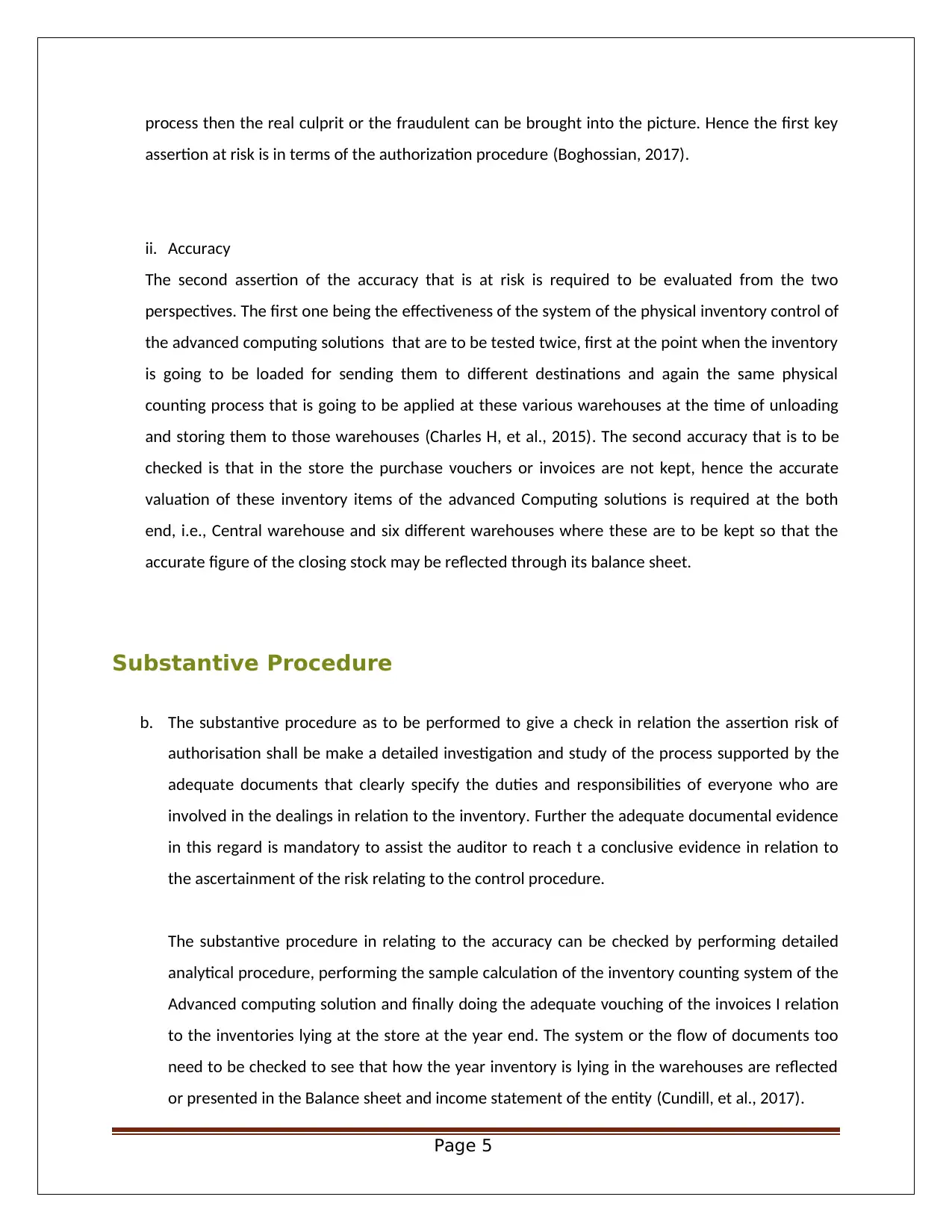
process then the real culprit or the fraudulent can be brought into the picture. Hence the first key
assertion at risk is in terms of the authorization procedure (Boghossian, 2017).
ii. Accuracy
The second assertion of the accuracy that is at risk is required to be evaluated from the two
perspectives. The first one being the effectiveness of the system of the physical inventory control of
the advanced computing solutions that are to be tested twice, first at the point when the inventory
is going to be loaded for sending them to different destinations and again the same physical
counting process that is going to be applied at these various warehouses at the time of unloading
and storing them to those warehouses (Charles H, et al., 2015). The second accuracy that is to be
checked is that in the store the purchase vouchers or invoices are not kept, hence the accurate
valuation of these inventory items of the advanced Computing solutions is required at the both
end, i.e., Central warehouse and six different warehouses where these are to be kept so that the
accurate figure of the closing stock may be reflected through its balance sheet.
Substantive Procedure
b. The substantive procedure as to be performed to give a check in relation the assertion risk of
authorisation shall be make a detailed investigation and study of the process supported by the
adequate documents that clearly specify the duties and responsibilities of everyone who are
involved in the dealings in relation to the inventory. Further the adequate documental evidence
in this regard is mandatory to assist the auditor to reach t a conclusive evidence in relation to
the ascertainment of the risk relating to the control procedure.
The substantive procedure in relating to the accuracy can be checked by performing detailed
analytical procedure, performing the sample calculation of the inventory counting system of the
Advanced computing solution and finally doing the adequate vouching of the invoices I relation
to the inventories lying at the store at the year end. The system or the flow of documents too
need to be checked to see that how the year inventory is lying in the warehouses are reflected
or presented in the Balance sheet and income statement of the entity (Cundill, et al., 2017).
Page 5
assertion at risk is in terms of the authorization procedure (Boghossian, 2017).
ii. Accuracy
The second assertion of the accuracy that is at risk is required to be evaluated from the two
perspectives. The first one being the effectiveness of the system of the physical inventory control of
the advanced computing solutions that are to be tested twice, first at the point when the inventory
is going to be loaded for sending them to different destinations and again the same physical
counting process that is going to be applied at these various warehouses at the time of unloading
and storing them to those warehouses (Charles H, et al., 2015). The second accuracy that is to be
checked is that in the store the purchase vouchers or invoices are not kept, hence the accurate
valuation of these inventory items of the advanced Computing solutions is required at the both
end, i.e., Central warehouse and six different warehouses where these are to be kept so that the
accurate figure of the closing stock may be reflected through its balance sheet.
Substantive Procedure
b. The substantive procedure as to be performed to give a check in relation the assertion risk of
authorisation shall be make a detailed investigation and study of the process supported by the
adequate documents that clearly specify the duties and responsibilities of everyone who are
involved in the dealings in relation to the inventory. Further the adequate documental evidence
in this regard is mandatory to assist the auditor to reach t a conclusive evidence in relation to
the ascertainment of the risk relating to the control procedure.
The substantive procedure in relating to the accuracy can be checked by performing detailed
analytical procedure, performing the sample calculation of the inventory counting system of the
Advanced computing solution and finally doing the adequate vouching of the invoices I relation
to the inventories lying at the store at the year end. The system or the flow of documents too
need to be checked to see that how the year inventory is lying in the warehouses are reflected
or presented in the Balance sheet and income statement of the entity (Cundill, et al., 2017).
Page 5
⊘ This is a preview!⊘
Do you want full access?
Subscribe today to unlock all pages.

Trusted by 1+ million students worldwide
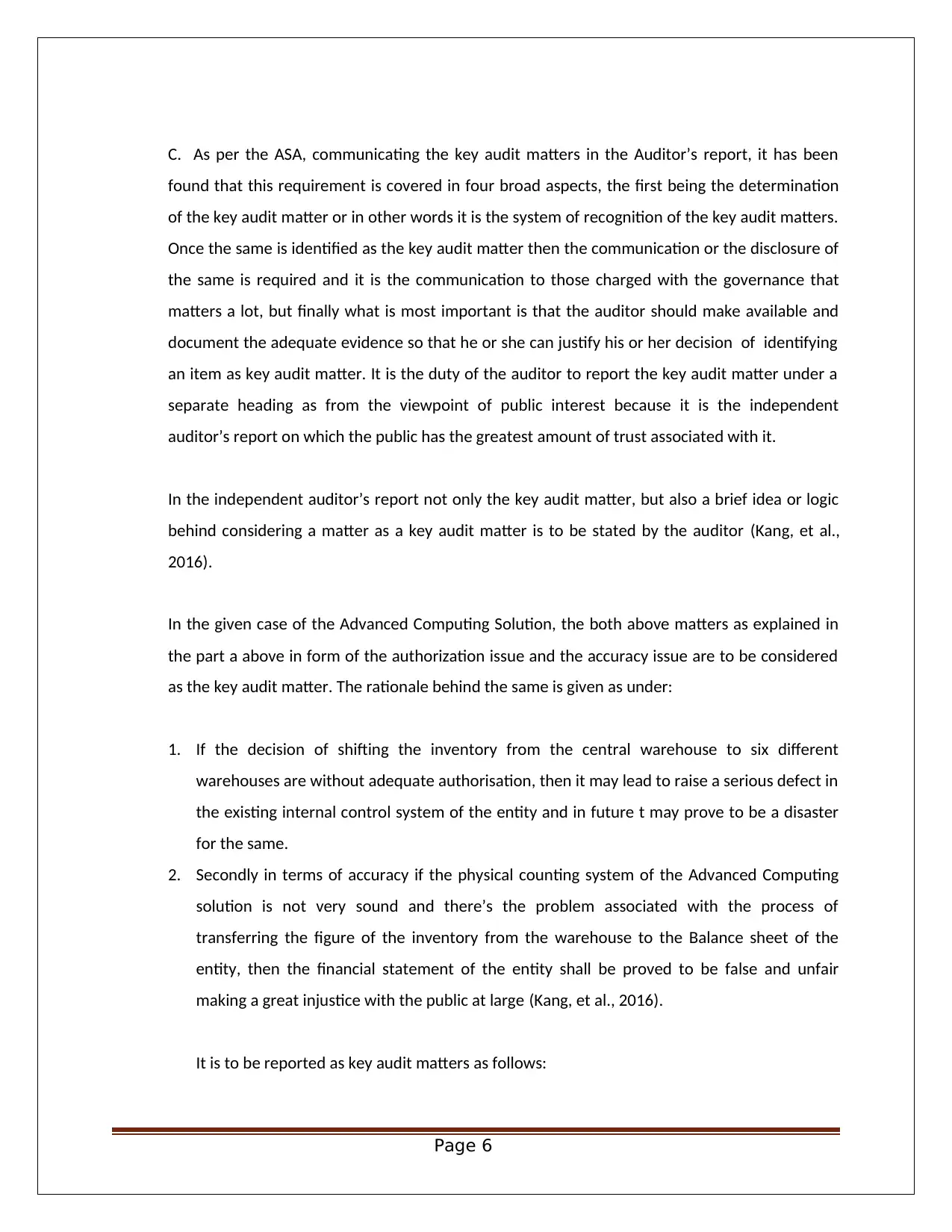
C. As per the ASA, communicating the key audit matters in the Auditor’s report, it has been
found that this requirement is covered in four broad aspects, the first being the determination
of the key audit matter or in other words it is the system of recognition of the key audit matters.
Once the same is identified as the key audit matter then the communication or the disclosure of
the same is required and it is the communication to those charged with the governance that
matters a lot, but finally what is most important is that the auditor should make available and
document the adequate evidence so that he or she can justify his or her decision of identifying
an item as key audit matter. It is the duty of the auditor to report the key audit matter under a
separate heading as from the viewpoint of public interest because it is the independent
auditor’s report on which the public has the greatest amount of trust associated with it.
In the independent auditor’s report not only the key audit matter, but also a brief idea or logic
behind considering a matter as a key audit matter is to be stated by the auditor (Kang, et al.,
2016).
In the given case of the Advanced Computing Solution, the both above matters as explained in
the part a above in form of the authorization issue and the accuracy issue are to be considered
as the key audit matter. The rationale behind the same is given as under:
1. If the decision of shifting the inventory from the central warehouse to six different
warehouses are without adequate authorisation, then it may lead to raise a serious defect in
the existing internal control system of the entity and in future t may prove to be a disaster
for the same.
2. Secondly in terms of accuracy if the physical counting system of the Advanced Computing
solution is not very sound and there’s the problem associated with the process of
transferring the figure of the inventory from the warehouse to the Balance sheet of the
entity, then the financial statement of the entity shall be proved to be false and unfair
making a great injustice with the public at large (Kang, et al., 2016).
It is to be reported as key audit matters as follows:
Page 6
found that this requirement is covered in four broad aspects, the first being the determination
of the key audit matter or in other words it is the system of recognition of the key audit matters.
Once the same is identified as the key audit matter then the communication or the disclosure of
the same is required and it is the communication to those charged with the governance that
matters a lot, but finally what is most important is that the auditor should make available and
document the adequate evidence so that he or she can justify his or her decision of identifying
an item as key audit matter. It is the duty of the auditor to report the key audit matter under a
separate heading as from the viewpoint of public interest because it is the independent
auditor’s report on which the public has the greatest amount of trust associated with it.
In the independent auditor’s report not only the key audit matter, but also a brief idea or logic
behind considering a matter as a key audit matter is to be stated by the auditor (Kang, et al.,
2016).
In the given case of the Advanced Computing Solution, the both above matters as explained in
the part a above in form of the authorization issue and the accuracy issue are to be considered
as the key audit matter. The rationale behind the same is given as under:
1. If the decision of shifting the inventory from the central warehouse to six different
warehouses are without adequate authorisation, then it may lead to raise a serious defect in
the existing internal control system of the entity and in future t may prove to be a disaster
for the same.
2. Secondly in terms of accuracy if the physical counting system of the Advanced Computing
solution is not very sound and there’s the problem associated with the process of
transferring the figure of the inventory from the warehouse to the Balance sheet of the
entity, then the financial statement of the entity shall be proved to be false and unfair
making a great injustice with the public at large (Kang, et al., 2016).
It is to be reported as key audit matters as follows:
Page 6
Paraphrase This Document
Need a fresh take? Get an instant paraphrase of this document with our AI Paraphraser
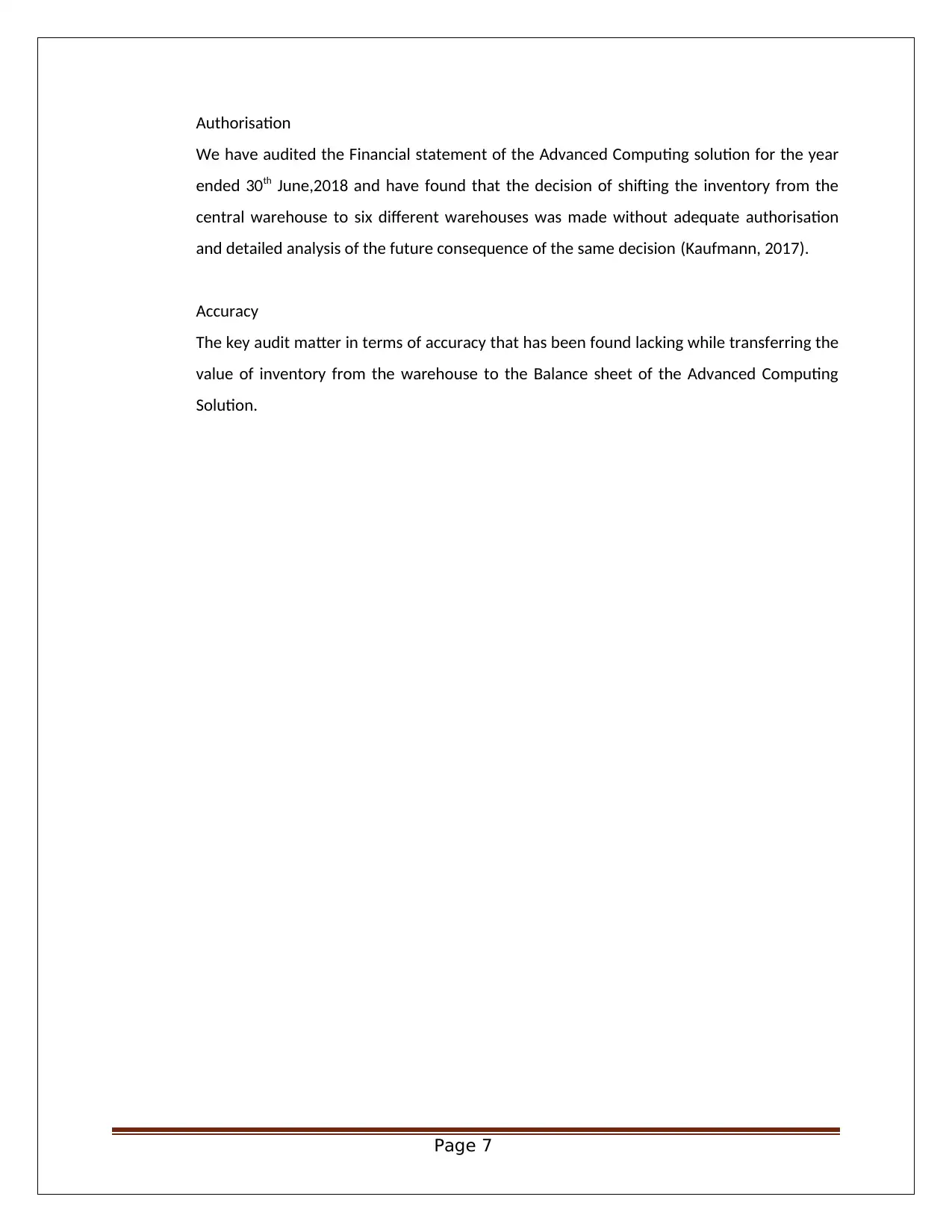
Authorisation
We have audited the Financial statement of the Advanced Computing solution for the year
ended 30th June,2018 and have found that the decision of shifting the inventory from the
central warehouse to six different warehouses was made without adequate authorisation
and detailed analysis of the future consequence of the same decision (Kaufmann, 2017).
Accuracy
The key audit matter in terms of accuracy that has been found lacking while transferring the
value of inventory from the warehouse to the Balance sheet of the Advanced Computing
Solution.
Page 7
We have audited the Financial statement of the Advanced Computing solution for the year
ended 30th June,2018 and have found that the decision of shifting the inventory from the
central warehouse to six different warehouses was made without adequate authorisation
and detailed analysis of the future consequence of the same decision (Kaufmann, 2017).
Accuracy
The key audit matter in terms of accuracy that has been found lacking while transferring the
value of inventory from the warehouse to the Balance sheet of the Advanced Computing
Solution.
Page 7
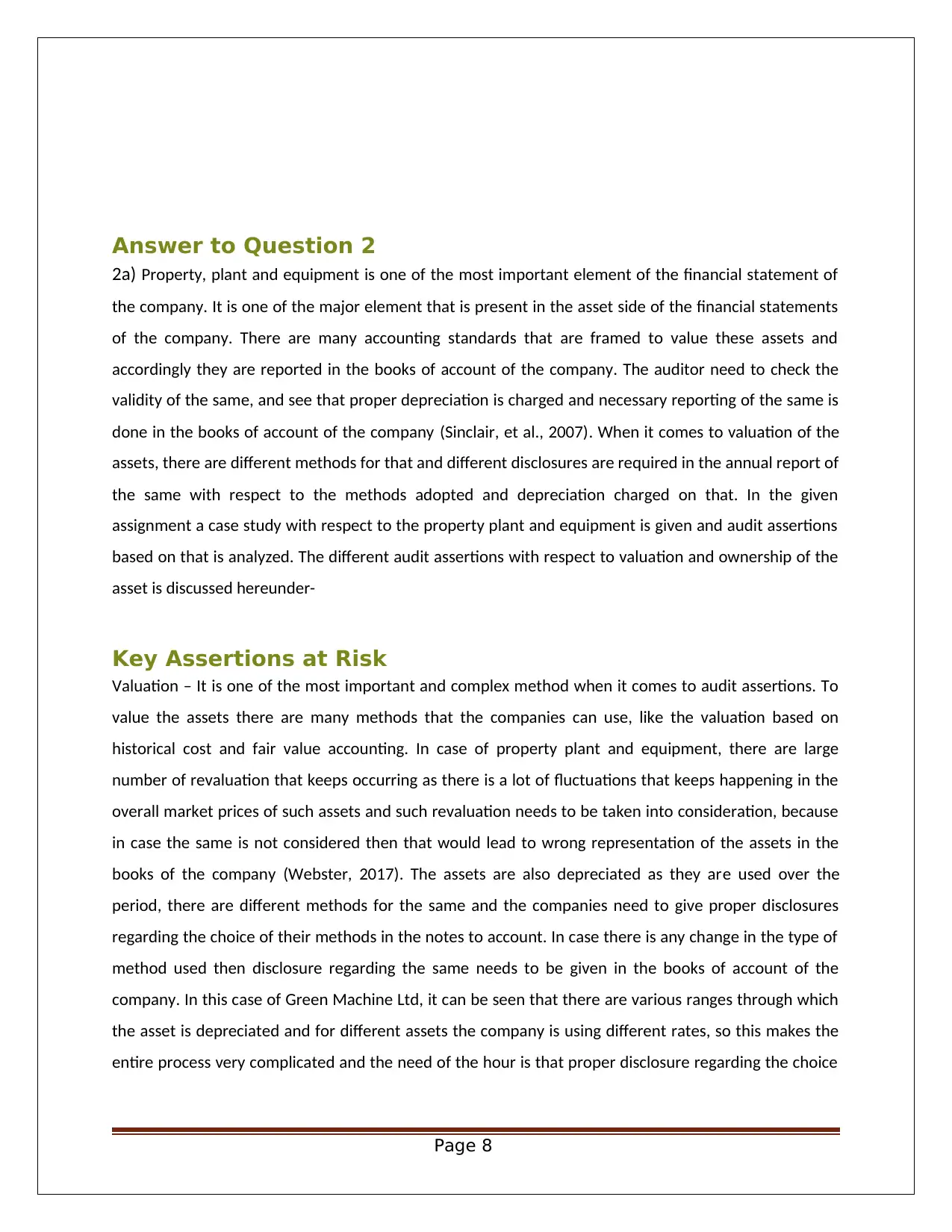
Answer to Question 2
2a) Property, plant and equipment is one of the most important element of the financial statement of
the company. It is one of the major element that is present in the asset side of the financial statements
of the company. There are many accounting standards that are framed to value these assets and
accordingly they are reported in the books of account of the company. The auditor need to check the
validity of the same, and see that proper depreciation is charged and necessary reporting of the same is
done in the books of account of the company (Sinclair, et al., 2007). When it comes to valuation of the
assets, there are different methods for that and different disclosures are required in the annual report of
the same with respect to the methods adopted and depreciation charged on that. In the given
assignment a case study with respect to the property plant and equipment is given and audit assertions
based on that is analyzed. The different audit assertions with respect to valuation and ownership of the
asset is discussed hereunder-
Key Assertions at Risk
Valuation – It is one of the most important and complex method when it comes to audit assertions. To
value the assets there are many methods that the companies can use, like the valuation based on
historical cost and fair value accounting. In case of property plant and equipment, there are large
number of revaluation that keeps occurring as there is a lot of fluctuations that keeps happening in the
overall market prices of such assets and such revaluation needs to be taken into consideration, because
in case the same is not considered then that would lead to wrong representation of the assets in the
books of the company (Webster, 2017). The assets are also depreciated as they are used over the
period, there are different methods for the same and the companies need to give proper disclosures
regarding the choice of their methods in the notes to account. In case there is any change in the type of
method used then disclosure regarding the same needs to be given in the books of account of the
company. In this case of Green Machine Ltd, it can be seen that there are various ranges through which
the asset is depreciated and for different assets the company is using different rates, so this makes the
entire process very complicated and the need of the hour is that proper disclosure regarding the choice
Page 8
2a) Property, plant and equipment is one of the most important element of the financial statement of
the company. It is one of the major element that is present in the asset side of the financial statements
of the company. There are many accounting standards that are framed to value these assets and
accordingly they are reported in the books of account of the company. The auditor need to check the
validity of the same, and see that proper depreciation is charged and necessary reporting of the same is
done in the books of account of the company (Sinclair, et al., 2007). When it comes to valuation of the
assets, there are different methods for that and different disclosures are required in the annual report of
the same with respect to the methods adopted and depreciation charged on that. In the given
assignment a case study with respect to the property plant and equipment is given and audit assertions
based on that is analyzed. The different audit assertions with respect to valuation and ownership of the
asset is discussed hereunder-
Key Assertions at Risk
Valuation – It is one of the most important and complex method when it comes to audit assertions. To
value the assets there are many methods that the companies can use, like the valuation based on
historical cost and fair value accounting. In case of property plant and equipment, there are large
number of revaluation that keeps occurring as there is a lot of fluctuations that keeps happening in the
overall market prices of such assets and such revaluation needs to be taken into consideration, because
in case the same is not considered then that would lead to wrong representation of the assets in the
books of the company (Webster, 2017). The assets are also depreciated as they are used over the
period, there are different methods for the same and the companies need to give proper disclosures
regarding the choice of their methods in the notes to account. In case there is any change in the type of
method used then disclosure regarding the same needs to be given in the books of account of the
company. In this case of Green Machine Ltd, it can be seen that there are various ranges through which
the asset is depreciated and for different assets the company is using different rates, so this makes the
entire process very complicated and the need of the hour is that proper disclosure regarding the choice
Page 8
⊘ This is a preview!⊘
Do you want full access?
Subscribe today to unlock all pages.

Trusted by 1+ million students worldwide
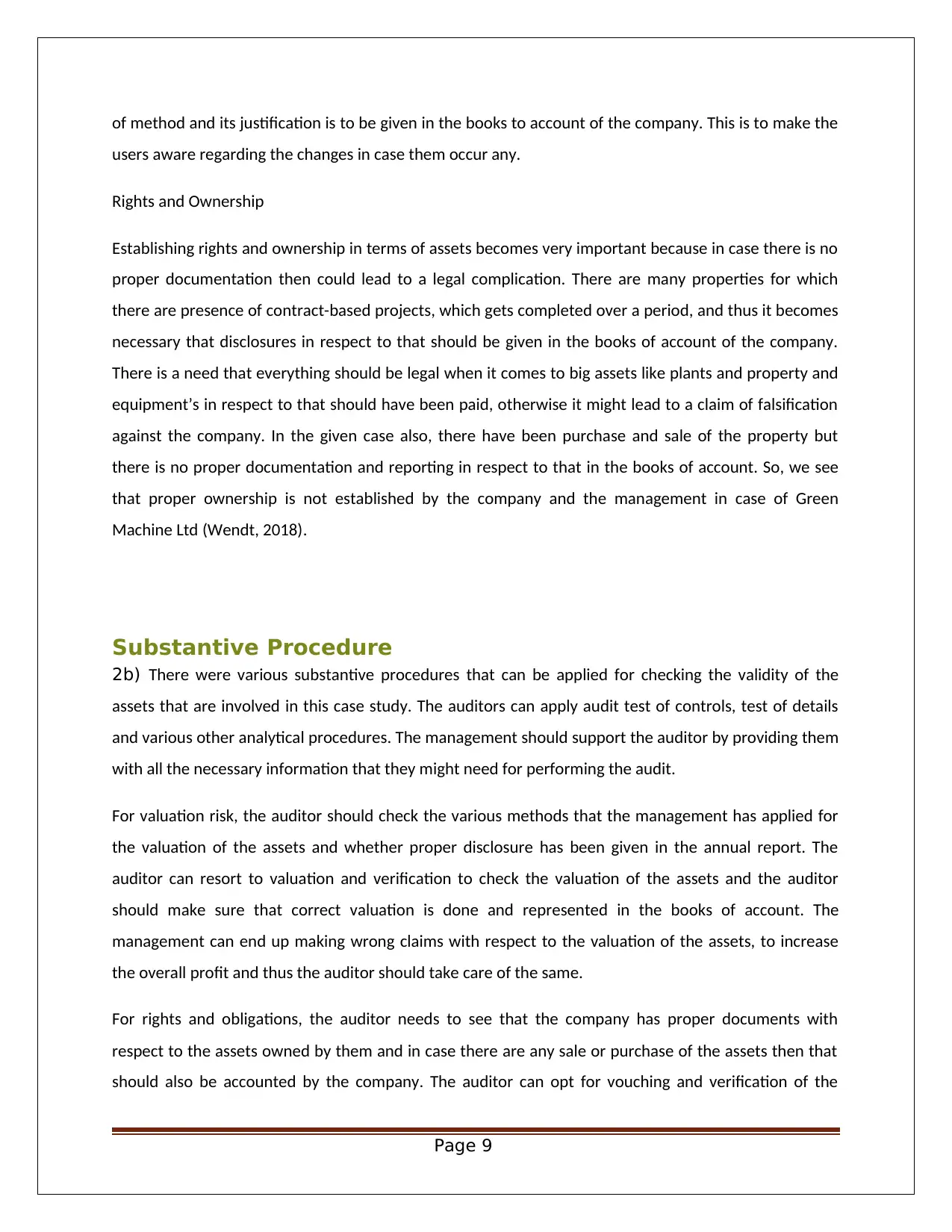
of method and its justification is to be given in the books to account of the company. This is to make the
users aware regarding the changes in case them occur any.
Rights and Ownership
Establishing rights and ownership in terms of assets becomes very important because in case there is no
proper documentation then could lead to a legal complication. There are many properties for which
there are presence of contract-based projects, which gets completed over a period, and thus it becomes
necessary that disclosures in respect to that should be given in the books of account of the company.
There is a need that everything should be legal when it comes to big assets like plants and property and
equipment’s in respect to that should have been paid, otherwise it might lead to a claim of falsification
against the company. In the given case also, there have been purchase and sale of the property but
there is no proper documentation and reporting in respect to that in the books of account. So, we see
that proper ownership is not established by the company and the management in case of Green
Machine Ltd (Wendt, 2018).
Substantive Procedure
2b) There were various substantive procedures that can be applied for checking the validity of the
assets that are involved in this case study. The auditors can apply audit test of controls, test of details
and various other analytical procedures. The management should support the auditor by providing them
with all the necessary information that they might need for performing the audit.
For valuation risk, the auditor should check the various methods that the management has applied for
the valuation of the assets and whether proper disclosure has been given in the annual report. The
auditor can resort to valuation and verification to check the valuation of the assets and the auditor
should make sure that correct valuation is done and represented in the books of account. The
management can end up making wrong claims with respect to the valuation of the assets, to increase
the overall profit and thus the auditor should take care of the same.
For rights and obligations, the auditor needs to see that the company has proper documents with
respect to the assets owned by them and in case there are any sale or purchase of the assets then that
should also be accounted by the company. The auditor can opt for vouching and verification of the
Page 9
users aware regarding the changes in case them occur any.
Rights and Ownership
Establishing rights and ownership in terms of assets becomes very important because in case there is no
proper documentation then could lead to a legal complication. There are many properties for which
there are presence of contract-based projects, which gets completed over a period, and thus it becomes
necessary that disclosures in respect to that should be given in the books of account of the company.
There is a need that everything should be legal when it comes to big assets like plants and property and
equipment’s in respect to that should have been paid, otherwise it might lead to a claim of falsification
against the company. In the given case also, there have been purchase and sale of the property but
there is no proper documentation and reporting in respect to that in the books of account. So, we see
that proper ownership is not established by the company and the management in case of Green
Machine Ltd (Wendt, 2018).
Substantive Procedure
2b) There were various substantive procedures that can be applied for checking the validity of the
assets that are involved in this case study. The auditors can apply audit test of controls, test of details
and various other analytical procedures. The management should support the auditor by providing them
with all the necessary information that they might need for performing the audit.
For valuation risk, the auditor should check the various methods that the management has applied for
the valuation of the assets and whether proper disclosure has been given in the annual report. The
auditor can resort to valuation and verification to check the valuation of the assets and the auditor
should make sure that correct valuation is done and represented in the books of account. The
management can end up making wrong claims with respect to the valuation of the assets, to increase
the overall profit and thus the auditor should take care of the same.
For rights and obligations, the auditor needs to see that the company has proper documents with
respect to the assets owned by them and in case there are any sale or purchase of the assets then that
should also be accounted by the company. The auditor can opt for vouching and verification of the
Page 9
Paraphrase This Document
Need a fresh take? Get an instant paraphrase of this document with our AI Paraphraser
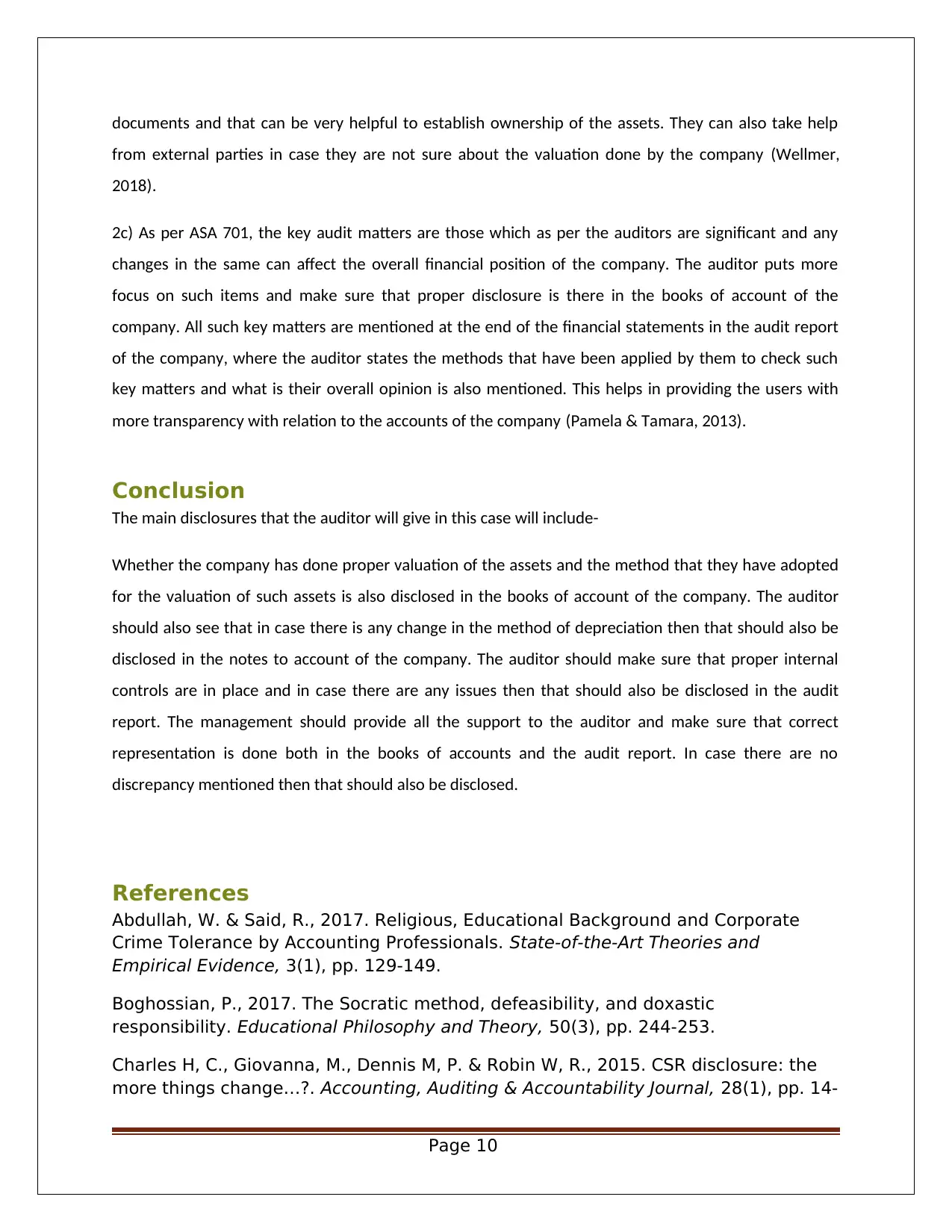
documents and that can be very helpful to establish ownership of the assets. They can also take help
from external parties in case they are not sure about the valuation done by the company (Wellmer,
2018).
2c) As per ASA 701, the key audit matters are those which as per the auditors are significant and any
changes in the same can affect the overall financial position of the company. The auditor puts more
focus on such items and make sure that proper disclosure is there in the books of account of the
company. All such key matters are mentioned at the end of the financial statements in the audit report
of the company, where the auditor states the methods that have been applied by them to check such
key matters and what is their overall opinion is also mentioned. This helps in providing the users with
more transparency with relation to the accounts of the company (Pamela & Tamara, 2013).
Conclusion
The main disclosures that the auditor will give in this case will include-
Whether the company has done proper valuation of the assets and the method that they have adopted
for the valuation of such assets is also disclosed in the books of account of the company. The auditor
should also see that in case there is any change in the method of depreciation then that should also be
disclosed in the notes to account of the company. The auditor should make sure that proper internal
controls are in place and in case there are any issues then that should also be disclosed in the audit
report. The management should provide all the support to the auditor and make sure that correct
representation is done both in the books of accounts and the audit report. In case there are no
discrepancy mentioned then that should also be disclosed.
References
Abdullah, W. & Said, R., 2017. Religious, Educational Background and Corporate
Crime Tolerance by Accounting Professionals. State-of-the-Art Theories and
Empirical Evidence, 3(1), pp. 129-149.
Boghossian, P., 2017. The Socratic method, defeasibility, and doxastic
responsibility. Educational Philosophy and Theory, 50(3), pp. 244-253.
Charles H, C., Giovanna, M., Dennis M, P. & Robin W, R., 2015. CSR disclosure: the
more things change…?. Accounting, Auditing & Accountability Journal, 28(1), pp. 14-
Page 10
from external parties in case they are not sure about the valuation done by the company (Wellmer,
2018).
2c) As per ASA 701, the key audit matters are those which as per the auditors are significant and any
changes in the same can affect the overall financial position of the company. The auditor puts more
focus on such items and make sure that proper disclosure is there in the books of account of the
company. All such key matters are mentioned at the end of the financial statements in the audit report
of the company, where the auditor states the methods that have been applied by them to check such
key matters and what is their overall opinion is also mentioned. This helps in providing the users with
more transparency with relation to the accounts of the company (Pamela & Tamara, 2013).
Conclusion
The main disclosures that the auditor will give in this case will include-
Whether the company has done proper valuation of the assets and the method that they have adopted
for the valuation of such assets is also disclosed in the books of account of the company. The auditor
should also see that in case there is any change in the method of depreciation then that should also be
disclosed in the notes to account of the company. The auditor should make sure that proper internal
controls are in place and in case there are any issues then that should also be disclosed in the audit
report. The management should provide all the support to the auditor and make sure that correct
representation is done both in the books of accounts and the audit report. In case there are no
discrepancy mentioned then that should also be disclosed.
References
Abdullah, W. & Said, R., 2017. Religious, Educational Background and Corporate
Crime Tolerance by Accounting Professionals. State-of-the-Art Theories and
Empirical Evidence, 3(1), pp. 129-149.
Boghossian, P., 2017. The Socratic method, defeasibility, and doxastic
responsibility. Educational Philosophy and Theory, 50(3), pp. 244-253.
Charles H, C., Giovanna, M., Dennis M, P. & Robin W, R., 2015. CSR disclosure: the
more things change…?. Accounting, Auditing & Accountability Journal, 28(1), pp. 14-
Page 10
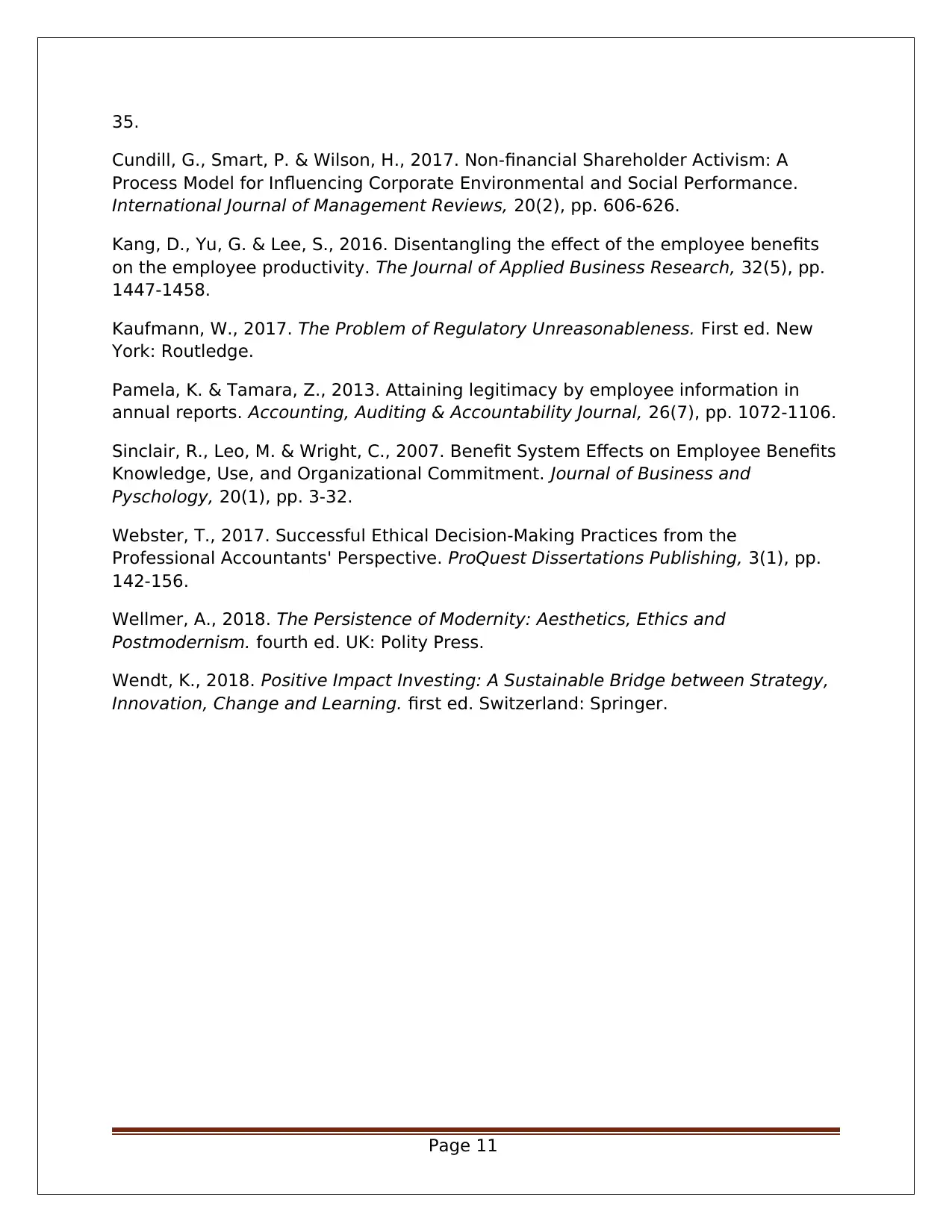
35.
Cundill, G., Smart, P. & Wilson, H., 2017. Non‐financial Shareholder Activism: A
Process Model for Influencing Corporate Environmental and Social Performance.
International Journal of Management Reviews, 20(2), pp. 606-626.
Kang, D., Yu, G. & Lee, S., 2016. Disentangling the effect of the employee benefits
on the employee productivity. The Journal of Applied Business Research, 32(5), pp.
1447-1458.
Kaufmann, W., 2017. The Problem of Regulatory Unreasonableness. First ed. New
York: Routledge.
Pamela, K. & Tamara, Z., 2013. Attaining legitimacy by employee information in
annual reports. Accounting, Auditing & Accountability Journal, 26(7), pp. 1072-1106.
Sinclair, R., Leo, M. & Wright, C., 2007. Benefit System Effects on Employee Benefits
Knowledge, Use, and Organizational Commitment. Journal of Business and
Pyschology, 20(1), pp. 3-32.
Webster, T., 2017. Successful Ethical Decision-Making Practices from the
Professional Accountants' Perspective. ProQuest Dissertations Publishing, 3(1), pp.
142-156.
Wellmer, A., 2018. The Persistence of Modernity: Aesthetics, Ethics and
Postmodernism. fourth ed. UK: Polity Press.
Wendt, K., 2018. Positive Impact Investing: A Sustainable Bridge between Strategy,
Innovation, Change and Learning. first ed. Switzerland: Springer.
Page 11
Cundill, G., Smart, P. & Wilson, H., 2017. Non‐financial Shareholder Activism: A
Process Model for Influencing Corporate Environmental and Social Performance.
International Journal of Management Reviews, 20(2), pp. 606-626.
Kang, D., Yu, G. & Lee, S., 2016. Disentangling the effect of the employee benefits
on the employee productivity. The Journal of Applied Business Research, 32(5), pp.
1447-1458.
Kaufmann, W., 2017. The Problem of Regulatory Unreasonableness. First ed. New
York: Routledge.
Pamela, K. & Tamara, Z., 2013. Attaining legitimacy by employee information in
annual reports. Accounting, Auditing & Accountability Journal, 26(7), pp. 1072-1106.
Sinclair, R., Leo, M. & Wright, C., 2007. Benefit System Effects on Employee Benefits
Knowledge, Use, and Organizational Commitment. Journal of Business and
Pyschology, 20(1), pp. 3-32.
Webster, T., 2017. Successful Ethical Decision-Making Practices from the
Professional Accountants' Perspective. ProQuest Dissertations Publishing, 3(1), pp.
142-156.
Wellmer, A., 2018. The Persistence of Modernity: Aesthetics, Ethics and
Postmodernism. fourth ed. UK: Polity Press.
Wendt, K., 2018. Positive Impact Investing: A Sustainable Bridge between Strategy,
Innovation, Change and Learning. first ed. Switzerland: Springer.
Page 11
⊘ This is a preview!⊘
Do you want full access?
Subscribe today to unlock all pages.

Trusted by 1+ million students worldwide
1 out of 12
Related Documents
Your All-in-One AI-Powered Toolkit for Academic Success.
+13062052269
info@desklib.com
Available 24*7 on WhatsApp / Email
![[object Object]](/_next/static/media/star-bottom.7253800d.svg)
Unlock your academic potential
© 2024 | Zucol Services PVT LTD | All rights reserved.




